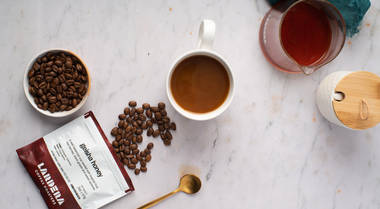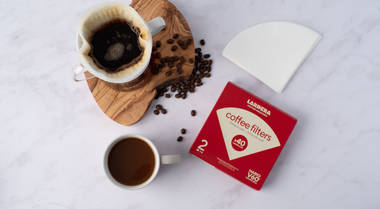Quick Guide to Coffee Beans and Caffeine
August 27, 2025
by Diana Rosen

Scientists, much later, realized that the perkiness the goats displayed was their reaction to caffeine, a central nervous system stimulant of the methyl xanthine class which also includes mateine, theophilline, and theobromine. We'd like to separate myth from fact about this common stimulant.
Does Caffeine Vary with Different Roasts?
Yes, but insignificantly.What is major, is the flavor! Most of coffee's natural flavors and fragrance are retained in a light roast; medium roast releases a sweeter flavor and fuller body as caramelization is released, and dark roasted beans have a flavor profile that's chocolatey, and surprisingly, higher in antioxidants. The darker the roast, the more moisture, and caffeine, is released.
The bigger differences are between the type of bean, Robusta and Arabica. Robusta beans have nearly twice the caffeine than Arabica beans. However, Arabica beans are generally grown at higher altitudes, are known for their elevated flavor profile, and the only beans used by specialty coffee vendors like Lardera.
All beans, no matter how they're roasted, retain the level of caffeine they had when harvested. What makes up the difference, albeit slight, is how the ground beans are measured.
Using a scoop for either light or dark roasts makes little difference. Using a scale measures the ground beans by weight, not quantity. Therefore, the darker beans will have more caffeine per cup.
Confused? Here's the clue. Roasting longer makes a bean lighter. So, even though the darker bean has slightly, ever so slightly, more caffeine, it also makes the beans lighter, requiring more of them to make up the same weight on the scale. Again, the difference is slight, so make your choice of roast based on its flavor, not its caffeine content.
Two other factors are important regarding caffeine punch: grind and brewing method.
For a high-caffeine punch, use a dark roast, grind it fine, and brew using a pour-over method. For a lower-punch of caffeine, use a light roasted bean, grind to a coarse level, and brew with a French press.

Can coffee interrupt sleep?
Maybe.This is another source of confusion. For some people, the caffeine in coffee has a contrarian effect: it relaxes them and is the perfect bedtime beverage. Coffee is also a relaxing beverage for some hyperactive adults because. However, for most people caffeine does stimulate in a healthful way to increase energy, cognition, and up your metabolism.
Even decaf contains 1 to 3% caffeine or about 7mg of caffeine compared to regular coffee which has 100mg.
While for some people coffee can reduce cholesterol and unclog arteries, for others it negatively impacts blood pressure and the heart. So, the caveat here is to "know thy body". If you're a contrarian, drink up; if not, drink coffee in moderation, 2 cups a day, and stop by 3 p.m. or at least six hours before bedtime as that's how long it takes for the body to eliminate the caffeine. Caffeine is also present in colas, chocolate, and to a lesser degree, in tea.
Is caffeine okay for children?
Nope.Children's tolerance for caffeine is much lower than adults. Kids who have too much caffeine via colas or chocolate, much less coffee, may experience mood changes, sleep issues, and increased irritability, particularly teenagers, so even hot chocolate should be a limited treat. If coffee is used as a treat, opt for at least half milk/half coffee for teens.
Ironically, for some children with hyperactivity or attention deficit concerns caffeine is a benefit. Studies have shown that caffeine works on them like it does on contrarians by having the opposite of its typical effect. Instead of jitteriness, caffeine helps these children relax and allows them to focus more deeply and for longer periods of time, a boon when they're in the schoolroom.
Is coffee is addictive?
Does it make one dependent? Maybe.Additive? Nope.
While defining caffeine as a possible dependence, without life-threatening withdrawal symptoms, it can take a day or two for some people to withdraw from caffeine. The good news is that caffeine consumption does NOT create emotional, social or economic health and lifestyle problems.
What caffeine can do, because it is a stimulant, is cause jitters or a feeling of nervousness, or give the impression that one is less tired than one really is. These are, of course, short-term impacts and will go away within hours or a day as the body eliminates the caffeine. As with anything, moderation is key. Two cups of day of the best coffee you can afford will lift your spirits, satisfy your taste buds, and keep your brain alert.
Does espresso have more caffeine than drip?
Depends on the quantity.A typical 8 oz. cup of drip coffee has 95mg of caffeine. A 1 oz. shot of espresso has 63mg so one serving of espresso has less than one serving of drip coffee. The humungous difference comes when we measure ounce per ounce. To wit: 8 oz. of drip coffee still has 95mg but 8oz. of espresso has 508mg of caffeine, more than the top level of recommended amount of caffeine per day of 400mg. If espresso is your jam, stick to one or two 1 oz. cups per day.
